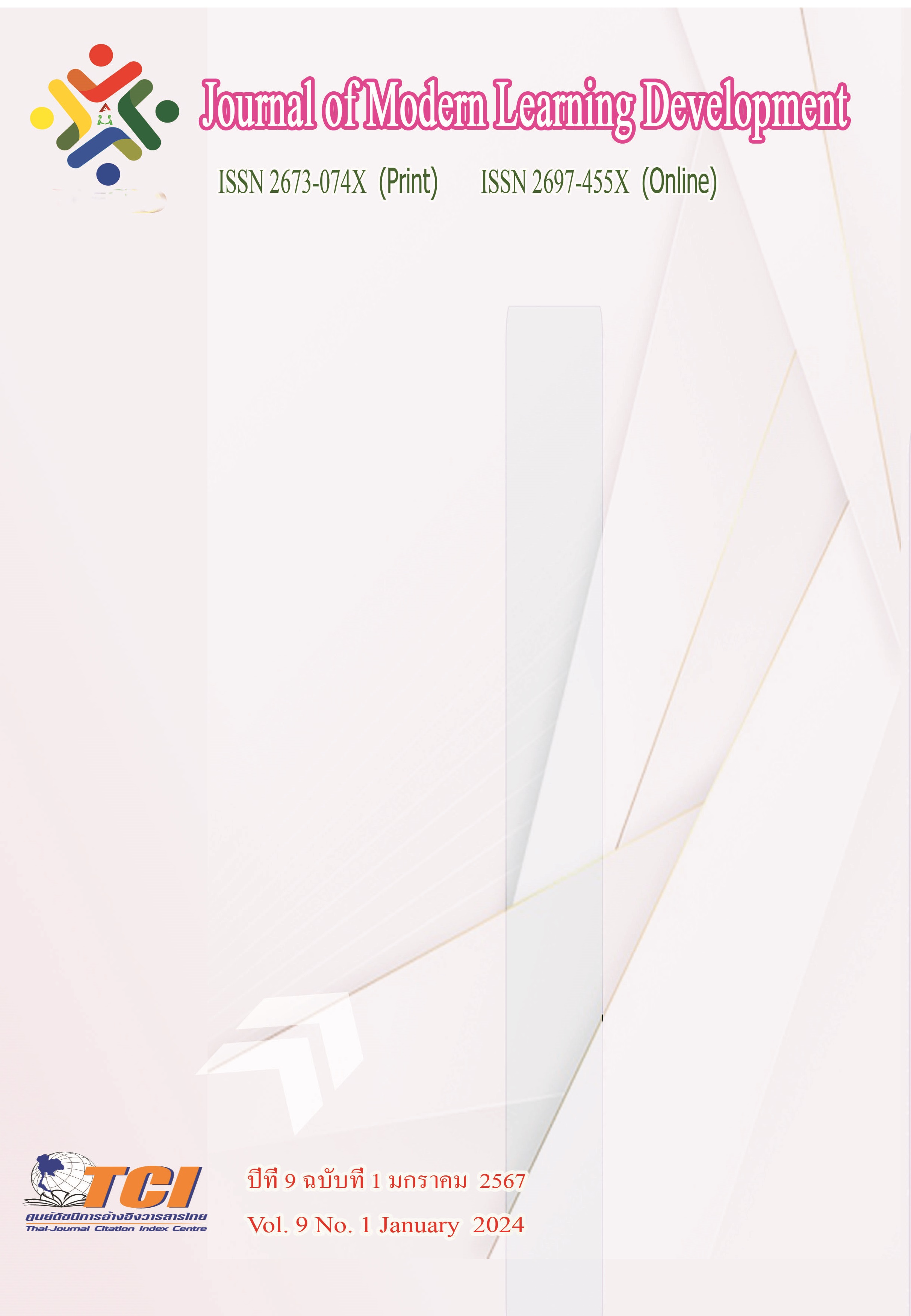Models for creating success of institutes of Vocational Education in the Northeast Region 3
Main Article Content
Abstract
This research aims to achieve the following objectives: 1.) Investigate the level of success. 2.) Examine the level of success of responsibilities. 3.) Identify the factors that contribute to success. 4.) Provide recommendations for fostering success. 5.) Models for creating success of institutes of Vocational Education in the Northeast Region 3. This is mixed-method research with questionnaire surveys and in-depth interviews. A sample group of 321 individuals from the Institutes of Vocational Education in the Northeast Region 3 was collected using systematic sampling. Statistical tools for data analysis include frequency distribution, percentages, mean, standard deviation, and multiple linear regression analysis.
The research findings indicate that: 1.) The overall level of success of Northeast Region 3 Institutions of Vocational Education is high, with an average value of 3.69. 2.) The overall level of success of responsibilities by Vocational Education in the Northeast Region 3 is high, with an average value of 3.99. 3.) There are eight factors that contribute to the success of Vocational Education in the Northeast Region 3. These factors include leadership or management, teacher or instructor factors, curriculum factors, student factors, institution factors, community and social participation factors, parent or relative factors, and decentralization factors. Together, they explain 71.1% of the overall variables, with an R-squared value of 0.711 and a statistical F-value of 118.442 at significant level of 0.01. The formular is as follows.
Unstandardized Multiple Linear Regression
y ̂ = 1.708+ .161 X2 + .051 X3 + .166 X4 + .089 X5 + .081 X6 + .073 X7 + .053 X9 + .104 X10
Standardized Multiple Linear Regression
z_y ̂ = .341Z4 + .179Z10 + .254Z2 +.116Z5 + .135Z7 + .133Z6 + .099Z9 + .080Z3 4.) Recommendations for fostering the success of Vocational Education in the Northeast Region 3 are as follows: Teachers should have a positive attitude and care equally for all students. Executives should demonstrate a vision for institution development that can be effectively implemented. There should be campaigns for public relations and community involvement, with active participation in institution-related activities. The institution should focus on developing practical skills in students rather than solely emphasizing documentation skills. 5.) The keys to success of Vocational Education in the Northeast Region 3 consist of a total of 16 factors, ranked in order of importance, as follows: Policy and strategic factors, leadership or management factors, teacher or instructor factors, curriculum factors, student factors, parent or relative factors, institution factors, economic factors, social value factors, connection factors, geographical factors, community participation factors, government agency and state official factors, equipment factors, budget factors, and technology factors.
Article Details
References
กรรัตน์ พิพัฒน์ผล. (2557). องค์ประกอบความสำเร็จของการจัดการอาชีวศึกษาในสถานประกอบการขนาดใหญ่. วิทยานิพนธ์ศึกษาศาสตรดุษฎีบัณฑิต สาขาการศึกษาตลอดชีวิตและการพัฒนามนุษย์. บัณฑิตวิทยาลัย: มหาวิทยาลัยศิลปากร.
ฉัตรกมล สมแตง. (2565). แนวทางการบริหารสู่โรงเรียนมาตรฐานสากลของโรงเรียน สังกัดสำนักงานเขตพื้นที่การศึกษาประถมศึกษาอุตรดิตถ์ เขต 2. วิทยานิพนธ์ครุศาสตรมหาบัณฑิต สาขาวิชาการบริหารการศึกษา. บัณฑิตวิทยาลัย: มหาวิทยาลัยราชภัฏอุตรดิตถ์.
ฉัตรกมล ตันชุน. (2560). ปัจจัยด้านคุณลักษณะของผู้บริหารที่ส่งผลต่อประสิทธิผลการบริหารงานของสถานศึกษา สังกัดสำนักงานเขตพื้นที่การสึกษาประถมศึกษาฉะเชิงเทรา เขต 2. ครุศาสตรมหาบัณฑิต สาขาวิชาการบริหารการศึกษา. บัณฑิตวิทยาลัย: มหาวิทยาลัยราชภัฏราชนครินทร์.
ฉัตรชัย พุ่มชูศักดิ์. (2564). รูปแบบการจัดการศึกษาที่บูรณาการการเรียนรู้กับการทำงานของสถานศึกษา สังกัดสำนักงานคณะกรรมการการอาชีวศึกษา. วิทยานิพนธ์การศึกษาดุษฎีบัณฑิต สาขาวิชาการบริหารการศึกษา. บัณฑิตวิทยาลัย: มหาวิทยาลัยนเรศวร.
ทิพวรรณ สำเภาแก้ว. (2560). ปัจจัยการบริหารที่ส่งผลต่อประสิทธิผลของสถานศึกษา สังกัดสำนักงานเขตพื้นที่การศึกษาประถมศึกษาสระบุรี เขต 2. วิทยานิพนธ์ ครุศาสตรมหาบัณฑิต สาขาวิชาการบริหารการศึกษา. บัณฑิตวิทยาลัย: มหาวิทยาลัยราชภัฏราชนครินทร์.
ธีรวุฒิ บุณยโสภณ. (2555). การบริการอาชีวะและเทคนิคศึกษาเพื่อพัฒนาอุตสาหกรรม. (พิมพ์ครั้งที่ 3).
กรงเทพมหานคร: มหาวิทยาลัยเทคโนโลยีพระจอมเกล้าพระนครเหนือ.
นฎกร ปั้นพุ่มโพธิ์. (2561). ปัจจัยที่ส่งผลต่อความสำเร็จในการบริหารสถานศึกษาของโรงเรียนสังกัดสำนักงานเขตพื้นที่การศึกษามัธยมศึกษา เขต 7. วารสารวิจัยทางการศึกษา คณะศึกษาศาสตร์มหาวิทยาลัยศรีนครินทร์วิโรฒ. ปีที่ 12 ฉบับที่ 1. 81-96.
นิพนธ์ แก้วกาหลง (2564). ปัจจัยทางการบริหารที่ส่งผลต่อประสิทธิผลในการจัดการศึกษาระบบทวิภาคีของวิทยาลัยในสังกัดอาชีวศึกษาจังหวัดสกลนคร. วิทยานิพนธ์ ครุศาสตรมหาบัณฑิต สาขาวิชาการบริหารการศึกษา. บัณฑิตวิทยาลัย: มหาวิทยาลัยราชภัฏสกลนคร.
พระราชบัญญัติการอาชีวศึกษา พ.ศ. 2551. (2551). ราชกิจจานุเบกษา. 125 ตอนที่ 43 ก. น.1-24.
พรรณวดี ปามุทา. (2559). ปัจจัยความสำเร็จในการบริหารจัดการโรงเรียนมาตรฐานสากลระดับประถมศึกษา สังกัดสำนักงานคณะกรรมการการศึกษาขั้นพื้นฐาน. วิทยานิพนธ์ปรัชญาดุษฎีบัณฑิต สาขาวิชาการบริหารการศึกษา. บัณฑิตวิทยาลัย: มหาวิทยาลัยสยาม.
มนทิพย์ ทรงกิติพิศาล. (2552). ปัจจัยที่ส่งผลต่อประสิทธิผลการบริหารสถานศึกษาขั้นพื้นฐานระดับมัธยมศึกษาในพื้นที่ภาคใต้ของประเทศไทย. วิทยานิพนธ์การศึกษาดุษฎีบัณฑิต. บัณฑิตวิทยาลัย: มหาวิทยาลัยรามคำแหง.
รัชนิกร อินทเชื้อ. (2563). ปัจจัยที่ส่งผลต่อความสำเร็จของการสร้างเครือข่ายการจัดการศึกษาของโรงเรียนผู้สูงอายุ. วิทยานิพนธ์รัฐประศาสนศาสตรมหาบัณฑิต. บัณฑิตวิทยาลัย: สถาบันบัณฑิตพัฒนบริหารศาสตร์.
วิโรจน์ สารรัตนะ. (2551). การบริหาร หลักการ ทฤษฎี ประเด็นทางการศึกษาและบทวิเคราะห์องค์การทางการศึกษาไทย. (พิมพ์ครั้งที่ 3). กรุงเทพมหานคร: ทิพยวิสุทธ์.
สำนักงานคณะกรรมการการอาชีวศึกษา. (2562). หลักเกณฑ์และแนวปฏิบัติการจัดการอาชีวศึกษา ระดับประกาศนียบัตรวิชาชีพและระดับประกาศนียบัตรวิชาชีพชั้นสูง. กรุงเทพมหานนคร: กระทรวงศึกษาธิการ.
Likert Rensis. (1969). The Method of Construction and Attitude Scale. New York: Wiley & Son.
Weber, Max. (1947). The Theory of Social and Economic Organization. New York: Free Press.


